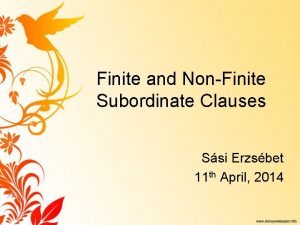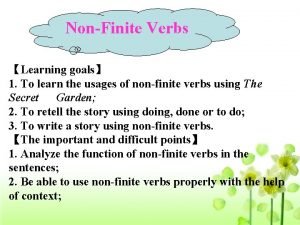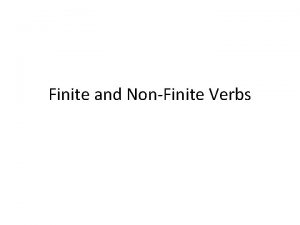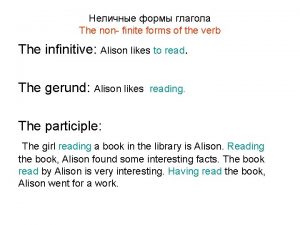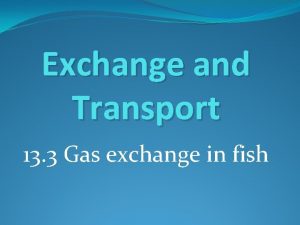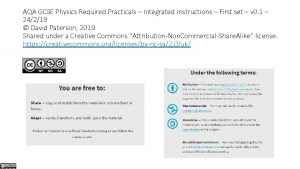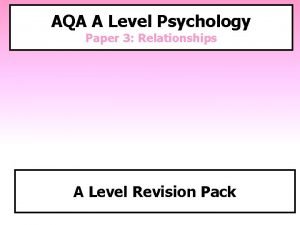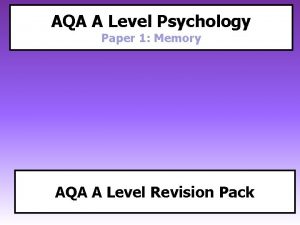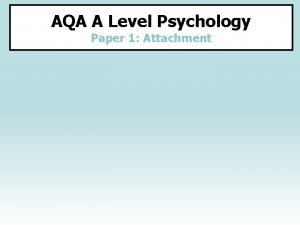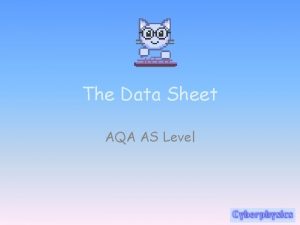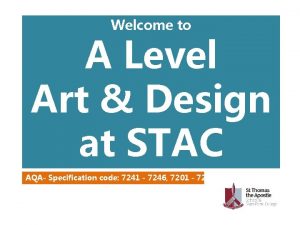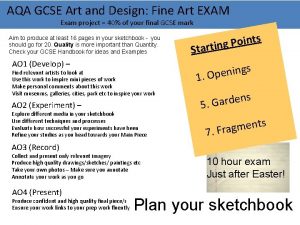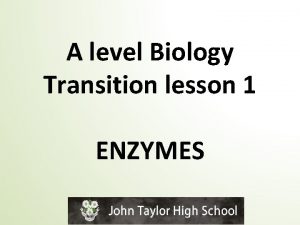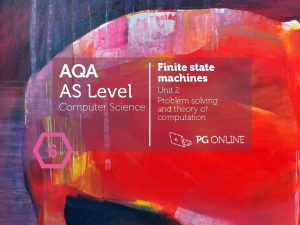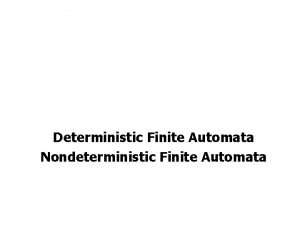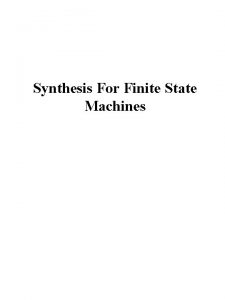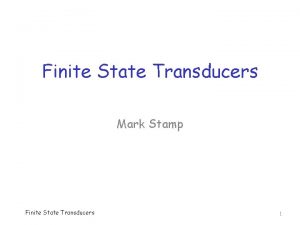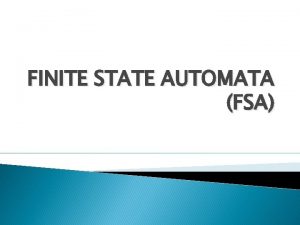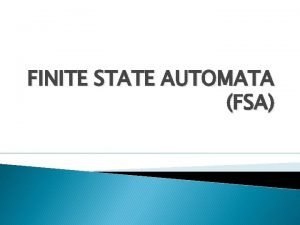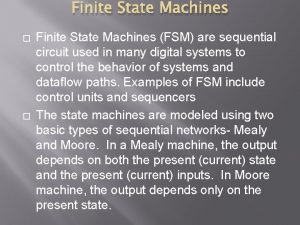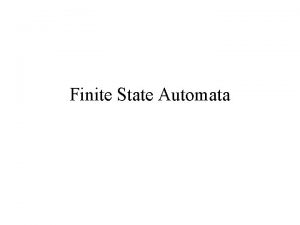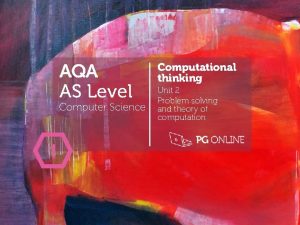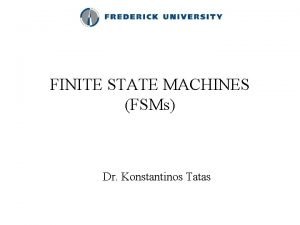AQA AS Level Computer Science 6 Finite state

















- Slides: 17

AQA AS Level Computer Science 6 Finite state machines Unit 2 Problem solving and theory of computation

Objectives • Understand what is meant by a finite state machine • List some of the uses of a finite state machine • Draw and interpret simple state transition diagrams for finite state machines with no output • Draw a state transition table for a finite state machine with no output and vice versa

Finite state machines Unit 2 Problem solving and theory of computation What is a finite state machine? • It is not a “machine” in the sense of some physical, mechanical thing with moving parts • It is an abstract representation of how something changes from one state to another in response to a condition or event

Finite state machines Unit 2 Problem solving and theory of computation In a finite state machine (FSM): • The machine can only be in one state at a time • It can change from one state to another in response to an event or condition; this is called a transition • The FSM is defined by a list of its states and the conditions for each transition • There can be outputs linked to the FSM’s state, but we will be considering only FSMs with no output

Finite state machines Unit 2 Problem solving and theory of computation Example: a turnstile • A turnstile is used to control access to a railway platform • It can be in one of two states: locked or unlocked • Inserting a ticket unlocks the turnstile, allowing a single customer to pass through • The arms are locked again until another coin is inserted

Finite state machines Unit 2 Problem solving and theory of computation FSM representing a turnstile • Pushing the arm when the turnstile is in the locked state has no effect • Putting another ticket in when in the unlocked state also has no effect

Finite state machines Unit 2 Problem solving and theory of computation Is the ticket valid? • Suppose the turnstile will not accept any ticket – it has to be a valid one for the journey • Can you draw a new state transition diagram with two extra inputs: valid ticket and invalid ticket? • There will be a third state – ticket inserted

Finite state machines Unit 2 Problem solving and theory of computation Answer:

Finite state machines Unit 2 Problem solving and theory of computation Applications of FSMs • Robotics • Video games industry • Design of digital hardware systems • Design of compilers and network protocols • Definition of languages, and to decide whether a particular word is allowed in a language

Finite state machines Unit 2 Problem solving and theory of computation Finite state automaton • A FSM which has no output is known as a finite state automaton • It has a start state and a set of end or accept states • If the automaton can reach a final state, it is said to accept the input • Starting in an initial state, the automaton processes a sequence of symbols and follows it to the target state • The symbols depend on the application – they usually represent events

Finite state machines Unit 2 Problem solving and theory of computation Notation Symbol Meaning State Start state End state or accept state Transition

Finite state machines Unit 2 Problem solving and theory of computation Recognising a language • A finite state system accepts a string c 1 c 2 c 3…. cn if there is a path from the start state to the end or accept state labelled by the symbols c 1, …. , cn • The language recognised by the FSM consists of all strings accepted by it.

Finite state machines Unit 2 Problem solving and theory of computation • Which of the following strings will be accepted by this finite state automaton? aaac badc adadbd ac bdaac bd

Finite state machines Unit 2 Problem solving and theory of computation Worksheet • Now try the questions in Task 1 of Worksheet 6

Finite state machines Unit 2 Problem solving and theory of computation State transition tables • An alternative representation of a FSM is a State Transition Table • The FSM below accepts two inputs a and b • The transition table shows what the next state is for any input. What strings does it accept? Next state Current state Input = a Input = b S 1 S 2

Finite state machines Unit 2 Problem solving and theory of computation Example • Complete the transition table for the FSM shown • Which of the following strings are accepted? 00100 0101 010000 Next state Current state Input = 0 Input = 1 S 2 S 3 S 1 S 2

Finite state machines Unit 2 Problem solving and theory of computation Worksheet • Now try the questions in Task 2
 Finite and non finite subordinate clauses
Finite and non finite subordinate clauses Learning objectives for finite and non finite verbs
Learning objectives for finite and non finite verbs Learning objectives for finite and non finite verbs
Learning objectives for finite and non finite verbs Finite and non-finite verb
Finite and non-finite verb Non finite forms of the verb qayda
Non finite forms of the verb qayda Gas exchange in fish a level biology aqa
Gas exchange in fish a level biology aqa Bbc bitesize stanislavski
Bbc bitesize stanislavski Physics required practicals
Physics required practicals Relationships psychology a level
Relationships psychology a level Aqa psychology a level paper 1
Aqa psychology a level paper 1 Schaffer and emerson stages of attachment
Schaffer and emerson stages of attachment Aqa a level physics data sheet
Aqa a level physics data sheet Aqa a level english literature b poetry anthology
Aqa a level english literature b poetry anthology Aqa religious studies a level past papers
Aqa religious studies a level past papers Aqa a level art and design
Aqa a level art and design Aqa art and design a level
Aqa art and design a level Art and design a level aqa
Art and design a level aqa Aqa a level biology transition guide answers
Aqa a level biology transition guide answers
